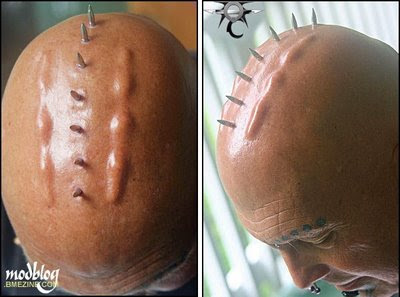
Body modification is not a new age hype. Although many people think body art or body modification is a creation of Western civilization, body art has been around since the dawn of man and has player a major part in all Eastern and other cultures. People look at body modification from different perspectives: parents look at it as a form of rebellion, Christians see it as a destruction of a body and thus a sin etc.
While some people consider body modification to be a sign of non-conformity, others see body modification as trend. However, this is not always the case.
What is body art?Body art is art made on human body. Most common forms of body art are tatoos, piercings, body painting, scarification or branding and scalpelling.
More extreme body art involves mutilation or pushing the body to its physical limits. Example of body mutilation is Lizard man and many other examples, while good example of pushing the body to its physical limits would be Marina Abramovic's works involved dancing until she collapsed from exhaustion.
As such expression, body art often appears as sub-category of performance art, where artists (ab)use their own body to make particular statements.
Tattoos Tattoo is a injected ink into a person's skin, commonly via needle, which forms a picture or a design. In technical terms, tattooing is dermal pigmentation, since the ink is injected in dermis, the second layer of the skin.
Tattoos have been used ornamentally and religiously by humans for thousands of years, despite having social stigma, as many other body modifications. Tattoos are used on humans and animals- on humans as a form of body modification, while in animals for identification.
Tattooing has been practiced worldwide for thousands and thousands of years, and despite some taboos following tattooing, like tattoos are worn by sailors, motorcyclers and some other 'lower' classes, the art of tattooing is still popular all over the world.
PiercingsPiercing is puncturing any part of the body in order to add jewelry or ornamentation. This jewelry or ornamentation is also simply called 'piercing'. People practice piercings from cultural or religious reasons. However, in Western world body piercings are used mostly for ornamental, and also for sexual reasons.
What body parts can be pierced? Almost every body parts- from the most common ear piercings (which are by my opinion even not considered as body art), to nose, tongue, lips, brows, navels, nipples, genitals, pocketing, etc.
Ear piercing has been the most popular, and has existed continuously since ancient time. I western culture ear piercing seems most conventional, even among men, which is the case from late 60s, while in non-western cultures ear piercing has always been practised by men.
Today, in Western culture, single or multiple piercing of either or both ears is extremely common among women and fairly common among men.
Body paintingBody painting is one of the oldest forms of body art. Unlike tatoos, body painting is temporary and lasts only several hours, or in case of henna tatoo, two to three weeks.
Form of body painting, expressed only on face, is known as face painting and is very popular for special occasions, like festivals etc. Most recognizable example of face paining is among clowns.
And do women paint their faces everyday? Yes, they do. We could hardy call this an art, but subdued forms of face paints for everyday occasions evolved into the cosmetics we know today.
Scarification or branding Scarification or branding is permanent body modification that uses
scar tissue
to form pictures, words, designs in the skin. Scarification is not a precise art: the type of scarification depends on the skin type, depth of the cut, healing process, etc. During the healing process scars spread and their shape cannot be predicted exactly. For that reason scarifications are very simple designs without any details, since they can be easily swallowed during the healing process. Scarification is a body modification where body, and not artist, creates its own 'art'.
Scarification has been often used as a rite of passage in adolescence, or in some cultures the willingness of a woman to receive scarification shows her maturity and willingness to bear children.
Scarification is still common among Australian Aboriginal tribes, which seems reasonable, since compared to tattoos, which is often not visible on darker skin, scarifications is much more evident.
Branding is a type of scarification, which has been historically used to mark slaves and criminals. The brand was usually visible (on neck, hand) and was often letter-coded to reflect the crime.
Scalpelling Scalpelling is a form of body art, very similar to body piercing, and is most commonly used as replacement for ear piercing. Scalpelling is performed with a scalpel and can produce holes with a larger diameter than can be achieved by piercing, which is typically performed with a hollow piercing needle or machine specifically designed for ear piercing. Since the hole, produced by scalpelling is larger, also larger can be accommodated in the hole.
Negative side effect of scalpelling is that hole created by the process is less likely to close naturally over time, but can be closed with some surgical procedures.
Scalpelling is most often used on earlobes, although theoretically it can be used to grow on almost every part of the body. Scalpelling is fairly new body modification technique, although it is more and more popular among younger population, especially in Europe.
Body Art as Art and Development In western culture body art became subcategory of art, in which artists use their (own) bodies in order to make specific statement. With the development of new technologies, artists, and not only them, but also doctors and other members of society are trying to bring human body in symbiosis with technological development: body in symbiosis with implants and/ or new technologies. New approach in body art is opening with the absence of body.
























